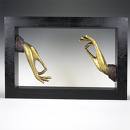Why Yoga?
It is the first thing in a long long time that I truly enjoy on a physical and spiritual level.
It can be spontaneous, soothing, enlightening and inspiring all at the same time.
Sometimes it forces me to remember I must shed my ego, other times I am bowed in humilty for days, and then other times I get out on the road and forget all of that. 😉
Seriously, I go through a day and forget to meditate and lose sight of the divine, depending on how busy I got. The goal is to serve the divine 24 hrs. a day. But I am a human learning about my spiritual and attempting to shed the physical.
Unfortunatly the physical takes over and I forget my spiritual side at times. I get caught up with my shop, or I get caught up with my cooking business, or I just get plain LAZY.
Urgh! I don’t even like the word lazy. But I have to be realistic in what it is. Some would say I actually need to train my sub concious and release my concious state. That is probably true.
What is even more amazing is over 4,000 years ago there was a being on this earth named Pantanjali. Pantanjali is the author of what are called Sutras. The Yoga Sutras to be specific.
Sutra – . (Non-Christian Religions / Hinduism) Hinduism Sanskrit sayings or collections of sayings on Vedic doctrine dating from about 200 ad onwards
2. (Non-Christian Religions / Hinduism) (modifier) Hinduisma. of or relating to the last of the Vedic literary periods, from about 500 to 100 bc the sutra periodb. of or relating to the sutras or compilations of sutras of about 200 ad onwards
3. (Non-Christian Religions / Buddhism) Buddhism collections of dialogues and discourses of classic Mahayana Buddhism dating from the 2nd to the 6th centuries a.d
Patañjali (Devanāgarī पतञ्जलि) (fl. 150 BCE[1] or 2nd c. BCE[2][3]) is the compiler of the Yoga Sutras, an important collection of aphorisms on Yoga practice, and also the author of the Mahābhāṣya, a major commentary on Panini’s Ashtadhyayi.
In recent decades the Yoga Sutra has become quite popular worldwide for the precepts regarding practice of Raja Yoga and its philosophical basis. “Yoga” in traditional Hinduism involves inner contemplation, a rigorous system of meditation practice, ethics, metaphysics, and devotion to God, or Brahman. At the same time, his Mahābhāṣya, which first foregrounded the notion of meaning as referring to categorization, remains an important treatise in Sanskrit linguistic philosophy.
Yoga Sūtras
The Yoga tradition is much older, there are references in the Mahabharata, and the Gita identifies three kinds of yoga, and it is also the subject of the late upanishad, Yogatattva. The Yoga Sūtras codifies the royal or best (rAja) yoga practices, presenting these as a eight-limbed system (ashtanga). The philosophic tradition is related to the Samkhya school. The focus is on the mind; the second sutra defines Yoga – it is the cessation of all mental fluctuations, all wandering thoughts cease and the mind is focused on a single thought (ekagrata). The eight limbs or the Ashtanga Yoga propounded here are
- yama, ethics, restraint and ahimsa,
- niyama, cleanliness, ascetism, etc.
- Asana, posture
- prANAyama, breath-control
- pratyahAra, sense-withdrawal
- dhAraNa, concentration
- dhyana meditation, and
- samAdhi, oneness with the Pranava of the Ishvara.
Expanded as this:-
Yama – non-violence, truthfulness, brahmacharya, non-accumulating/non-coveting
Niyama – Tapas (Discipline)- Svadhyaya (Self Study) – Ishvara Pranidhana (Surrender to God/Higher Self) – Contentment/Acceptance
Asana – Discipline of the body
Pranayama – Breath Control
Pratyhara – withdrawal of all senses
Dharana – Concentration/Expand awareness beyond oneself
Dhyana – Meditation
Samadhi – oneness with the Pranava







